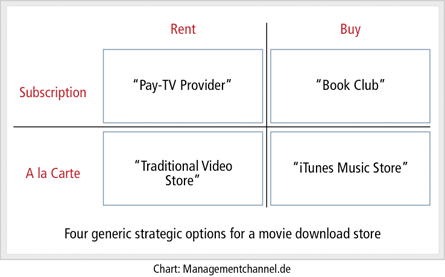Apple’s next big thing (2): The end of TV as we know it
Four weeks ago, on September 7th, Steve Jobs unveiled not only the iPod nano, but also Apple’s latest strategic weapon:
„This next statistic we’ve never shared with anybody before: How many accounts do we have on iTunes? How many accounts? We have just crossed 10 million accounts on iTunes. And they come with credit cards. (…) And with 10 million accounts, that makes iTunes one of the largest internet stores around. (…) iTunes may be the second largest internet store behind only Amazon.“
You might ask, “Where’s the weapon”?
Apple has now accumulated 10 million customer accounts and every single customer is able to buy products from Apple by a single click on the mouse button. No painstaking registration procedures, no worries about sending credit card data over the Internet… – heaven on earth for unpremeditated buying. A low barrier for its customers between the desire to buy and an actual purchase: that’s what every retailer lusts after.
Those 10 million customer accounts constitute what management scholars refer to as strategic resource, i.e. a resource that is valuable, idiosyncratic, imperfectly imitable, and imperfectly substitutable. Strategic resources build the core of successful businesses.
But how can Apple leverage this important asset? What kind of new products or services is Apple going to sell to its 10 million Music Store customers?
Is Apple going to compete with Amazon and start selling books, CDs and DVDs? That seems unlikely. One of Apple’s competitive advantages is in delivering intangible digital products over the Internet (e.g. iTunes Music Store, Quicktime movie trailer portal). Thus it should be some kind of digital product or service.
As Apple is rumored to work on an “iPod video”, let’s assume that the missing intangible product is: movies.
The question is: How could Apple gain a competitive advantage over its established competitors in the movie business, namely television, pay-TV, and video stores?
The answer can be derived from analyzing the different strategic options for entering this market. The movie market can be systematized by using two criteria:
- Does the consumer buy or rent the content?
- Does the consumer pay for each movie “a la carte” or does he pay a subscription-fee?
Thus four generic options are available:
- Rent & Subscription: Apple could act like a pay-TV provider; the consumer would have to pay a monthly fee to get access to a limited or unlimeted catalog of content.
- Buy & A la Carte: Apple could sell movies the same way they sell music over the iTunes Music Store.
- Buy & Subscription: Apple could port the book club’s business model to the Internet. Customers make a certain buying commitment, e.g. to buy “one download per months for $9,99” or “five downloads per quarter for $39,90”.
- Rent & A la Carte: Apple could offer content on a “pay-per-view”-basis. Customers would choose movies from a broad catalog of content and were allowed to watch them for a certain period of time.

For several reasons the fourth model (Rent & A la Carte) seems to be the most attractive:
- Apple ties in an established consumer behavior: renting movies through a video store.
- Apple offers a significant customer benefit: An online download store could feature a larger catalog than any traditional video store; the desired movie would never be out; and the store would be just a few feet away from the sofa.
- Direct competition with pay-TV providers on a saturated pay-TV market is avoided. It may be easier to win new customers with an innovative service than to alienate them from established competitors.
- The decision to watch a movie is a spontaneous decision. Many consumers could prefer an easy-to-use “a la carte”-service over a pay-TV subscription or over the scheduled offerings of a TV-channel.
- In the age of globalization an increasing number of people live and work permanently or temporarily far from home. Thus there’s a growing demand for globally accessible regional content.
- The market for niche content is undeveloped. A globally accessible store platform and low publishing costs could build a profitable market for various specialized content providers (e.g. a Chess-Channel, a Badminton-Channel etc.)
- In contrast to the cable companies‘ fibre connections the Internet already exists; capital investments for Apple are low.
- The „A la carte“ model is based upon Apple’s strategic “10 million customers” resource. It would be difficult for competitors to imitate Apple’s strategy.
This could be the end of video stores, pay-TV and television as we know it.

